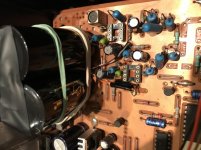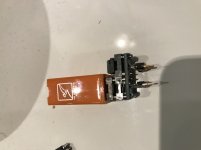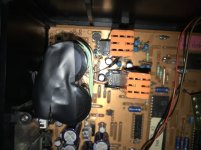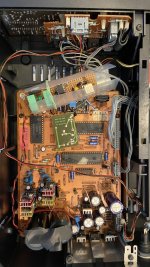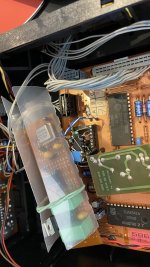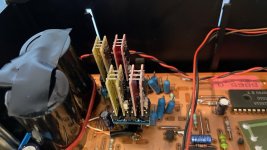Hello, fellow diy and music loving friends!
I'd like to share with you my experience with Burson Audio V6 Classic opamps that were offered as free samples by mr. Carlos here on DiyAudio forum.
If this is a wrong location for this kind of post, moderator please move it to where it is appropriate.
I confess I'm a member of the TDA1541A "cult" and I believe that CD red book has enough information to sound really really good if the I2S signal and power supplies are done right. So what I like to do is get an old Marantz or Philips CD player and mod it using the information found mostly on this forum and also elsewhere on the web.
The newest project that I haven't made inoperable yet (fingers crossed) is a Marantz CD-273. It's a cheap nothing special player which originally sounds just ok. It had the LM833N opamps. I put the Bursons in but wasn't impressed much. It sounded better, but it was still somehow restrained and uninteresting to listen to. So I decided to mod it a little and bypassed everything behind the opamps so that the signal goes straight to good audio output caps and rca connectors. This unveiled the music quite a bit. Then i removed the SAA7220 oversampling and filtering chip and installed a reclock thingy that realigns the I2S signal before entering the TDA1541A. This mod also removed signal oversampling and cleared the 5V psu line of one noisy chip. Now the CD player sounds so much better it's barely recognizable and is actually a pleasure to listen to. Now it's a good enough platform for testing opamps.
The CD player originally uses one double opamp per channel where the left side of the opamp amplifies the signal and the right side buffers it. I used double and also single opamps with singles to double adapters.
I tried:
- NE5534N from Philips
- NE5534N from Signetics
- LME49720HA
- LME49710HA
- OPA637BP
- AD797AN
The Philips NE5534N were the most natural sounding with good dynamics and detail. Quite enjoyable really.
Signetics had deeper bass, but were
somehow muffled.
LME497x0HA were a tad more detailed, but a bit lacking in the midrange which made them too clinical.
OPA637BP distorted probably because of too low gain setting.
AD797 was soundwise somewhere inbetween the both NE5534Ns.
And then came the Bursons.
Since they are singles I put them in with Philips as buffers and the combo sounded better than an all Philips combo right away!
Great, then I tried them with every other opamp as buffer and the best buffer were the AD797s. The sound was natural, detailed, dynamic with deep enough well defined bass. The vocals were just amazing and level of dynamics which gives the music its emotions was comparable to a tube amplifier.
It's clear as day that these opamps are the best I have ever heard and they sound better than I thought opamps ever could.
Now I'm curious how much further I can push this CD player, as it seems the better it is, the more Bursons shine.
I'll replace the clock with a TentLabs one and sort out power supplies a little and then post my findings in this thread.
At the end I'd like to thank mr. Carlos for the wonderful opportunity to try the Burson V6 Classic opamps.
Thank you!
I'd like to share with you my experience with Burson Audio V6 Classic opamps that were offered as free samples by mr. Carlos here on DiyAudio forum.
If this is a wrong location for this kind of post, moderator please move it to where it is appropriate.
I confess I'm a member of the TDA1541A "cult" and I believe that CD red book has enough information to sound really really good if the I2S signal and power supplies are done right. So what I like to do is get an old Marantz or Philips CD player and mod it using the information found mostly on this forum and also elsewhere on the web.
The newest project that I haven't made inoperable yet (fingers crossed) is a Marantz CD-273. It's a cheap nothing special player which originally sounds just ok. It had the LM833N opamps. I put the Bursons in but wasn't impressed much. It sounded better, but it was still somehow restrained and uninteresting to listen to. So I decided to mod it a little and bypassed everything behind the opamps so that the signal goes straight to good audio output caps and rca connectors. This unveiled the music quite a bit. Then i removed the SAA7220 oversampling and filtering chip and installed a reclock thingy that realigns the I2S signal before entering the TDA1541A. This mod also removed signal oversampling and cleared the 5V psu line of one noisy chip. Now the CD player sounds so much better it's barely recognizable and is actually a pleasure to listen to. Now it's a good enough platform for testing opamps.
The CD player originally uses one double opamp per channel where the left side of the opamp amplifies the signal and the right side buffers it. I used double and also single opamps with singles to double adapters.
I tried:
- NE5534N from Philips
- NE5534N from Signetics
- LME49720HA
- LME49710HA
- OPA637BP
- AD797AN
The Philips NE5534N were the most natural sounding with good dynamics and detail. Quite enjoyable really.
Signetics had deeper bass, but were
somehow muffled.
LME497x0HA were a tad more detailed, but a bit lacking in the midrange which made them too clinical.
OPA637BP distorted probably because of too low gain setting.
AD797 was soundwise somewhere inbetween the both NE5534Ns.
And then came the Bursons.
Since they are singles I put them in with Philips as buffers and the combo sounded better than an all Philips combo right away!
Great, then I tried them with every other opamp as buffer and the best buffer were the AD797s. The sound was natural, detailed, dynamic with deep enough well defined bass. The vocals were just amazing and level of dynamics which gives the music its emotions was comparable to a tube amplifier.
It's clear as day that these opamps are the best I have ever heard and they sound better than I thought opamps ever could.
Now I'm curious how much further I can push this CD player, as it seems the better it is, the more Bursons shine.
I'll replace the clock with a TentLabs one and sort out power supplies a little and then post my findings in this thread.
At the end I'd like to thank mr. Carlos for the wonderful opportunity to try the Burson V6 Classic opamps.
Thank you!
Attachments
Cool project, thanks for sharing it.
I wouldn't mind having a go at an old cheap CD player to see how it sounds using the double bursons that I was so lucky to receive.
I wouldn't mind having a go at an old cheap CD player to see how it sounds using the double bursons that I was so lucky to receive.
Because the opamps sample giveaway was here and I didn't know where exactly would be the best place for a review of a commercial product and swap meet is a commercial part of the forum.
I was informed that the Burson V6 Vivid, requires approximately 90 hours of Burn In Time for it to offer its full potential.
The Device I have, has a Single V6 Vivid in use.
All components have been brand new in the device, I have heard it improve over time, especially in the Bass Notes, there is much more noticeable Bass Authority, than when first used.
The Device I have, has a Single V6 Vivid in use.
All components have been brand new in the device, I have heard it improve over time, especially in the Bass Notes, there is much more noticeable Bass Authority, than when first used.
Hello again!
The V6 Vivid opamps arrived a while ago and...
sorry no spoilers. 🙂
Let's go step by step - in between I upgraded my CD player with a TentLabs low jitter clock powered by a homemade Flea voltage regulator.
The effect was profound regarding the sound image resolution (more detail) and the soundstage got more depth. The CD player rose to a seriously good sounding level.
Then I put the Vivids in instead of Classics (both are singles followed by a buffer opamp) and music retained the detail and got more free in a sense somehow.
Then I wanted to try Bursons all the way - for amplifying and buffering the signal, but they couldn't fit on the single-to-dual adapter. So I had to strip them of their otherwise nice casings and oh my, it was worth it.
Especially with the Vivids as amplifiers and Classics as buffers after a few days of break-in it got in the ballpark of "the best I have ever heard". Vivids are all as good as Classics, but even more natural sounding.
So there you go. Pricewise it all depends on a persons budget, but if you can afford them, you won't be sorry.
I wanted to make a tube analog stage for the CD player, but I'm in no hurry now because I sincerely doubt it could beat the Bursons.
Thanks again to Carlos from Burson Audio for this wonderful and fun experience.
The V6 Vivid opamps arrived a while ago and...
sorry no spoilers. 🙂
Let's go step by step - in between I upgraded my CD player with a TentLabs low jitter clock powered by a homemade Flea voltage regulator.
The effect was profound regarding the sound image resolution (more detail) and the soundstage got more depth. The CD player rose to a seriously good sounding level.
Then I put the Vivids in instead of Classics (both are singles followed by a buffer opamp) and music retained the detail and got more free in a sense somehow.
Then I wanted to try Bursons all the way - for amplifying and buffering the signal, but they couldn't fit on the single-to-dual adapter. So I had to strip them of their otherwise nice casings and oh my, it was worth it.
Especially with the Vivids as amplifiers and Classics as buffers after a few days of break-in it got in the ballpark of "the best I have ever heard". Vivids are all as good as Classics, but even more natural sounding.
So there you go. Pricewise it all depends on a persons budget, but if you can afford them, you won't be sorry.
I wanted to make a tube analog stage for the CD player, but I'm in no hurry now because I sincerely doubt it could beat the Bursons.
Thanks again to Carlos from Burson Audio for this wonderful and fun experience.
Last edited:
